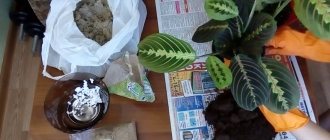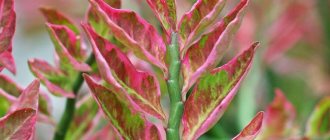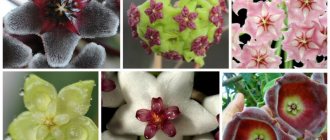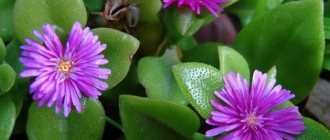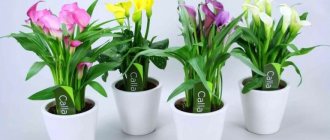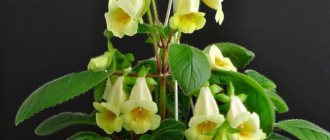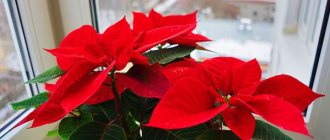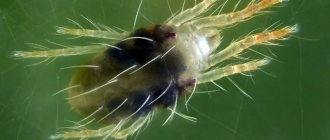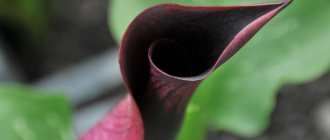Philodendron Sello is a very interesting plant with beautiful leaves that will ideally decorate a large, bright room. It also perfectly purifies the air, absorbing toxic substances and destroying harmful microbes.
Description
Philodendron belongs to the genus of evergreen flowering perennials and belongs to the Araceae family. In the wild, these plants are most often found in the humid tropical climates of Mexico and America. They grow both in forests and in swampy areas, on river banks, and along roads. Philodendrons can climb other plants and trees using their aerial roots. This is why they got their name, which is translated from ancient Greek as a combination of the words “love” and “tree”.
Philodendrons have aerial and underground roots. They need the former for attachment to trees and plants, as well as for transporting water and nutrients. Leaves of different shades of green are arranged alternately, are large in size (up to 2 m) and varied in shape, which at a young age may differ from the shape of the leaves of an adult plant. The inflorescence is a white spadix with a two-color thick spathe.
The philodendron fruit is a white berry with a greenish tint.
Botanical description
The shape of the plant can be varied: epiphyte, semi-epiphyte, terrestrial plant in the form of a flexible vine or subshrub.
The root system is superficial and branches well. The stem is quite thin, its length varies from a few centimeters to 2-3 m. Over time, the base of the stem becomes so woody that support is no longer needed. The bark is brownish, flaking.
The leaves are very decorative. The leaf blade can reach a length of up to 2 m. They are arranged alternately, attached to long petioles. They can be oval, arrow-shaped, finger-dissected or have a dissection in the form of a pattern. Moreover, the shape of the leaves can change several times during the life cycle of the plant. The main color is various shades of green, there are variegated forms. The vine also grows cataphylls - these are scale-like leaves that serve as protection for vegetative buds. The leaves fall off, leaving indentations on the trunk where the petioles attach.
How philodendron blooms
Philodendron flowering photo
The flowering is a spadix surrounded by a spathe. It is located on a dense short stalk, colored in a light green, cream or pinkish tint. Its length is about 25 cm. The bedspread has a cream or reddish tint. At the top of the spadix are the male reproductive flowers, then the gap is filled with sterile flowers, and at the bottom are the female ones.
But the activity of male flowers does not coincide with the activity of female flowers - pollination requires several inflorescences, which open at different times. At first, the cob grows vertically, slightly covered with a blanket, then bends slightly, and the blanket moves to the side. Philodendron is pollinated by bread beetles and beetles.
Then the cob returns to an upright position and is completely covered with a blanket. On one plant during flowering, 1-11 inflorescences open. The fruit is a juicy berry, the ripening of which can last about 1 year. At this time, the cob is under a tightly closed blanket. The ripe fruit has a white, yellow, greenish tint. It is filled with very small seeds.
Various types of philodendron can often be found in greenhouses and botanical gardens, but some of them are adapted to indoor conditions. Even an inexperienced gardener can care for this vine.
Peculiarities
Philodendron Sello has another name: bipinnate. In nature, it lives in the forest tropics of Bolivia, southern Brazil, and northern Argentina. It has a straight, short woody trunk, on which traces of fallen leaves form beautiful patterns. The leathery leaves are arrow-shaped, twice pinnately dissected, up to 90 cm in length. They are green with a gray tint and have long petioles. Nowadays, Philodendron Sello is often grown as a spectacular greenhouse and indoor plant.
Species of Philodendron
Philodendron name | Description of the species |
| Sello | The stem is tree-like, 200 cm high, straight. The leaves are 75-95 cm long, divided into lobules. The edges of the leaves are wavy. The plant looks like a tree. |
| Blushing | Climbing liana. The stem length is 150 cm. Young plants have a stem with a reddish tint. Growing up, the color becomes gray-green. The leaves are arrow-shaped, 17-26 cm long and 15-20 cm wide. In young plants, the leaf color is brown-red, in an adult plant it is dark green with red edges. The plant is shade-tolerant. |
| Warty | A climbing vine with heart-shaped leaves, the leaf structure is velvety. The petioles are covered with warty bristles. Particularly demanding on growing conditions - high air humidity, favorable temperature for growth - 22-27 degrees, frequent abundant watering. |
| Guitar-shaped | The stem grows up to 200 cm long. It needs support. The leaves are 50 cm long, spade, dissected into 5 lobes, and look like a guitar. It is not picky about living conditions, but requires regular feeding. |
| Hastate | The liana is fast growing. The leaves are spear-shaped, dissected, up to 45 cm long. In adult plants, over time, the cut of the leaves at the base becomes deeper, the leaf becomes slightly wavy. |
| climbing | The liana is fast growing. Annual growth is 100 cm. The leaves are glossy, heart-shaped, 12-14 cm long. Loves warmth and abundant watering. |
| Xanadu | Tree-like plant, diameter 200 cm, height 150 cm. Leaves are pinnate, 40 cm long. Easy to care for, does not require pruning. |
| Bipinnate | The climbing vine has a short powerful trunk, narrow, long arrow-shaped leaves, reaching up to 90 cm. The leaves can be whole or dissected into 10 lobes. |
| Brilliant | Indoor liana. The stem is thin, the leaves are small—up to 10 cm long and 5 cm wide, velvety, reddish in color. Easy to care for. |
| Golden-black Andre | During the growth period, the appearance of the plant changes. Young plants have copper-red leaves up to 7 cm long. At an older age, the leaves reach a length of up to 80 cm, the shape is oblong-heart-shaped, the leaf color is bronze-green. There is a light border along the edges. The room temperature should not exceed 20 degrees, natural lighting, moderate watering. |
Care instructions
Philodendron selloum is not a very difficult houseplant to grow. But you should know that it needs large spaces for good growth. In addition, its sap is poisonous, so trim the plant only with gloves and keep children and pets away from contact with it. To grow a healthy, beautiful plant, carefully study the rules of care .
Lighting
The plant loves bright, diffused light. Excessive lighting causes the leaf blades to turn pale. Do not expose the leaves to direct sunlight, otherwise burns are inevitable. With insufficient light, the leaves fade and lose their decorative effect.
Temperature
Philodendron Sello feels great at a temperature of +17–+25°C. In winter, the ideal temperature is not lower than +14°. It needs regular ventilation of the room, but drafts are detrimental to this plant.
Air humidity
This representative of the tropics loves high humidity (about 70%). Mist your philodendron daily using a fine mist sprayer to keep the leaves streak-free. To increase air humidity, you can place the plant on a tray with moistened pebbles or place an aquarium nearby.
Watering
Abundant and frequent watering with soft, settled water at room temperature is recommended. The soil should always be slightly moist. Be sure to drain excess water from the pan to prevent root rot.
Top dressing
In the spring-summer period, 2 times a month it is necessary to apply special fertilizers for plants with decorative foliage.
Trimming
In spring, philodendron is cut below the upper tier zone at the aerial roots, leaving a small stem. It is recommended to pinch shoots above the upper internodes to prevent the plant from growing too much. Aerial roots can be shortened a little, but cannot be cut off. They should be directed downwards and buried.
Philodendron pruning
- Prune in the spring before the active growth period begins.
- Leave the stem length about 40 cm.
- The cut location is below the zone of the upper tier of aerial roots.
- To limit the size of the plant, periodically pinch the shoots. Do this over the top internode.
- Remove dying leaves at any time.
- Aerial roots can be shortened, but do not cut them off completely.
Transfer
Actively growing young philodendrons need annual replanting; adult plants need to be replanted every few years. You can purchase special soil for these plants or mix equal amounts of orchid soil and peat. If you want to prepare the mixture yourself, then take:
- 1 part turf;
- 3 parts leaf soil;
- 1 part sand.
Features of planting and transplanting
Tropical vines require a lightweight substrate that is water- and breathable. The reaction of the selected soil must be neutral or slightly acidic. In the natural environment, philodendrons grow in soil that contains a high content of rotted wood and fallen leaves. In the case of a purchased mixture, a Saintpaulia substrate is suitable. When making a soil mixture yourself, you need:
- garden soil - 3 parts;
- orchid bark – 4 lobes;
- perlite – 1 part;
- peat mixture – 2 shares.
But it is also possible to create another substrate, which will contain turf soil, leaf turf and sand in proportions of 1:3:1. It is possible to add a little bone meal (horn shavings) to the soil mixture to increase the nutritional value of the substrate for philodendron. Also, if the perennial is not a bush plant, a support is immediately prepared for it - for small specimens, a “ladder” made of strong wire, and for adult plants, a purchased one is also suitable.
On a note!
If the support is made of a pipe, then it is kept slightly moist, and during the growing season it is regularly sprayed with diluted fertilizers of low concentration.
Adult specimens are replanted once every 2-3 years; in the case of young ones, they need a new larger container annually. The procedure is carried out using the transshipment method, without damaging the earthen coma. When the philodendron is too large, the top layer of the substrate is renewed. To do this, remove 5 cm of the old soil mixture. It is better to replant the plant in the spring season.
A transplant must be done in the following situations:
- The substrate has become excessively dense or moss has begun to grow on it.
- The roots of the plant are visible from the drainage holes or the leaf blades gradually become smaller.
- There are pests in the soil or the philodendron looks sick.
- Whitish stains appeared on the surface of the soil mixture in the pot.
The container where the philodendron will be transplanted must have drainage holes. The plant also needs a layer of expanded clay or other material with similar properties. After transplantation, the philodendron is shaded and watering is reduced until the plant adapts (approximately 2 weeks). When a perennial has been purchased in a store, it is transplanted into a permanent container immediately, while the root system is inspected. When the rhizomes have completely “mastered” the soil, take a pot larger in diameter than the shipping container. The philodendron is buried to the same level as it was, the root collar must remain above the level of the substrate.
Reproduction
This species is difficult to propagate by cuttings, since it has practically no stem. Therefore, Philodendron Sello "Mexican snake" is grown from seeds. They can be purchased in specialized stores. Try growing philodendron from seeds at home using the following algorithm:
- soak the seeds for a day in a solution with growth stimulants (for example, potassium humate, HB-101);
- Use a sharp needle to scratch the seeds so that their shell is damaged;
- in a container with loose soil, previously calcined and poured boiling water, place the seeds on the surface;
- lightly sprinkle them with the earthen mixture and spray them with a spray bottle;
- cover with a transparent bag or glass on top;
- Place the mini-greenhouse in a warm place with good lighting.
- ventilate the greenhouse every day, leaving it open for a few minutes, and moisten the soil so that it does not dry out;
- when the seeds germinate (after about 1.5–2 months), remove the bag and continue care;
- Pick up the seedlings only when a pair of true leaves appear on the plants.
How to care for seedlings?
Further care of the seedlings is the same as when growing seedlings of other indoor plants. The greenhouse must be ventilated daily, opening the cap for a few minutes, and periodically spray the soil, preventing it from drying out.
It is worth noting that you will have to wait quite a long time for the first shoots of philodendron - sprouts will appear no earlier than in 1.5 months.
When the seeds germinate, remove the cap and continue caring for the seedlings. You can put them into a separate container when two true leaves have formed on the bushes. The next transplant is done a year later in the spring, changing the pot to a more spacious one.
We grow at home
This is a shade-loving plant and the majority of varieties are able to reach maturity only under certain circumstances. Therefore, most species are grown in greenhouses. However, philodendron can also develop at home, but for this you need to create a comfortable microclimate and properly care for it.
Lighting
He feels good in diffused but bright light, but direct sunlight is destructive for him. Due to exposure to ultraviolet radiation, the leaves begin to turn yellow and fall off. Light adjustment depends on the variety and type of philodendron. It will be able to form powerful, spreading bushes with sufficient lighting. Some species do well in artificial light, others require a place on the east or northwest side.
Humidity, temperature
This is a resident of humid forests, so you need to prepare the place in advance and maintain a certain humidity. An abundance of watering will not be able to compensate for dry air. In the warm season, spring and summer, the plant needs to be sprayed. In summer, a small plant is given a kind of shower. In winter, it is better to place it away from heating appliances. If this is not possible, radiators should be covered with a damp cloth, wetting it periodically. Some gardeners advise placing a container with sphagnum moss, which has low thermal conductivity, next to it.
In addition, in winter, no matter what type of philodendron it is, it is not recommended to keep it near a window. Frost is as dangerous as the sun's rays. Regardless of the time of year, you should regularly wipe the leaves with a damp cloth.
Philodendron, is it possible to keep such a moisture-loving plant at home? Yes, you can, if you maintain the optimal temperature for it. For the warm season, the optimal temperature is considered to be from 22 to 25 degrees. The plant can tolerate an increase in the temperature on the thermometer, provided there is a sufficient degree of humidity.
The cold season is not so important for it, but the temperature should not fall below 15 degrees. The amount of watering is significantly reduced, which will subsequently prevent rotting of the root system. It is recommended to provide additional lighting through the use of fluorescent lamps.
Watering
Before watering, you need to check the soil. The earthen ball must be moistened. If the top is one third dry, then the plant is ready for watering. Reducing watering is carried out in the autumn. In winter, it is completely reduced, keeping the soil only moist.
Philodendron at home is watered with warm, settled water. It should be soft with a low acid-base balance. Once the soil is completely moist, drain the excess water from the pan.
Feeding
Caring for philodendron also includes feeding. Under natural conditions, the plant feeds on leaf humus, waste products of animals, insects and rainwater.
At home, it is fed with ready-made fertilizers intended for ornamental leafy plants. The finished concentrates contain equal proportions of nitrogen, potassium, and phosphorus. Philodendron is fed from March to September.
Feeding tips:
- Feeding is carried out once every two weeks if the plant is outdoors;
- If it is located in a warm room, it is fed only once a month;
- An ampelous plant with a tree-like stem can be fertilized with aged compost. It is added in the summer, only once during transplantation. Compost is added to the topsoil;
- If humus was added, then fertilizing with other types of fertilizers is carried out no earlier than after 2 months;
- Fertilizing is carried out only after thorough watering, when the entire earthen ball is well moistened;
- There are instructions on the packages of ready-made fertilizers. However, flower growers recommend reducing the specified concentration of the composition by 20 percent.
Diseases
Not only insects, but also diseases can attack philodendron.
| SYMPTOMS | REASON/WHAT TO DO |
| The stems are rotting | Stem rot. The reason is a special type of fungus formed from excess moisture in winter and autumn. The plant needs to be replanted, reduce watering |
| Leaves are falling from the tops | In winter, the temperature was high, due to the close location next to the radiator. Moderate leaf death in the lower part of the trunk is considered normal. |
| The main stem is exposed at the bottom | Lack of light |
| The tops of the leaves have acquired a brownish tint | Reduce watering |
Homemade philodendron is easy to care for; you just need to follow the general recommendations.
Transfer
Home care for philodendron includes replanting. This process should be carried out in spring, when the plant is full of vitality. Young animals are transplanted annually. The process is then carried out every 3-4 years.
For large plants, only the top layer of soil, 5 centimeters thick, is changed. The climbing philodendron also needs to be replanted, but after that, you need to lightly pinch its elongated thin stems at the ends. This contributes to the emergence of new shoots.
If the plant was recently purchased, then it is necessary to check its root system. Have the roots entwined the entire earthen lump? The plant needs to be transplanted into a larger container. Otherwise, it will stop its growth and development.
When replanting, special attention is paid to the soil. Its base (substrate) must have a slightly acidic, or preferably neutral, environment. The permissible pH ranges from 5.5 to
Philodendron leaves love the organic matter found in the soil. The optimal ratio is 90 percent of humus from the total amount. At the same time, the base should have a loose structure, which promotes oxygen saturation. You can use ready-made substrates for deciduous trees.
Many gardeners prepare the substrate themselves:
| Turf | 1 part |
| Humus soil | 2 parts |
| High peat | 1 part |
| Sand | 0.5 parts |
As a base for the soil, use ready-made soil for orchids or make drainage from wine corks. Transplantation is carried out by transferring an earthen clod along with the plant.
Philodendron care
Philodendron is a rather unpretentious plant. However, in order for him to feel comfortable and actively develop, a number of simple conditions must be observed.
Philodendron requires regular watering. It is undesirable to allow the soil to dry out. If you water a flower rarely, this may affect its appearance. In this case, the leaves of philodendrons become small and lose their attractiveness.
The air when growing philodendrons should be sufficiently humid. The flower reacts to its dryness by shredding the leaves and losing their decorative properties. Therefore, in hot summers and winters, when the heating is turned on, the philodendron should be sprayed regularly - at least once a day.
Fertilizers for decorative foliage plants are perfect for philodendron
In summer, plants need to be fed with regular store-bought fertilizers at least weekly; in winter, monthly feeding is sufficient. If the vine is large, you can add humus once in the summer to the top layer of the substrate.
Philodendron is fed only after thorough watering, otherwise excess salts in the soil can harm it. When choosing fertilizers, it is recommended to purchase complex ones. If you want to speed up the growth of a flower, you should feed it with compounds containing a high nitrogen content.
The plant does not tolerate excess fertilizer well - its leaves rust and wither. If too much fertilizer is added, then the philodendron does not need to be fed for at least 2 months.
A plant bought in a store should start feeding after 2–4 weeks, and if you grew it yourself, then when the first shoots appear. Plants that have been transplanted do not need to be fed for the first six months.
If the philodendron is not replanted on time and fed irregularly, the leaves will begin to become smaller and the tips will turn yellow and dry out. The plant begins to grow more slowly, and underfeeding negatively affects the thickness of the trunk.
Philodendron home propagation
It is bred in spring or summer. Philodendron propagation is carried out in several ways:
- Seeds
- Vegetatively (tops, stem segments, leaves with a “heel”)
Philodendron from seeds
Growing philodendron from seeds is not difficult, as is using other well-known methods. In order for the stems and seeds to strengthen, light soil is needed. To do this, mix peat and sand in equal quantities. The stalk is placed in the soil with the bud up and lightly sprinkled with sand, after which the base is well moistened and covered with polyethylene or glass. Several times a week (2-3) glass and polyethylene are removed briefly for ventilation. This will help avoid rotting.
Philodendron vegetative propagation
The vegetative method of propagation is carried out by planting aerial roots in the ground. The apical method is called when the apical shoots are used for propagation. They are planted in moistened sand, the temperature range of which is 22-26 degrees. They are covered with film or glass on top.
Planted cuttings are ventilated daily. After they have roots, which can be identified by a new leaf, they are transplanted into pots 10 centimeters high. Propagation has a beneficial effect on an old plant. It produces new side shoots and acquires more vital energy.
Reviews about the plant
The support for the philodendron should not be smooth
Future owners of philodendrons should be guided not only by their appearance, but also by the amount of space in the room. Tree varieties are particularly demanding of living space. Most often they are used to decorate country houses and office spaces due to their large size. At the same time, we should not forget that a lack of living space leads to significant injury to plants, falling and withering of leaves. As a result, the philodendron may lose its attractiveness.
If the choice is in favor of vines, they should be provided with comfortable support. Such philodendrons cling to aerial roots during growth. Therefore, the choice should be made on supports wrapped in suitable material, for example, moss or coconut fiber. Branched stands also look great. When skillfully pinching the shoots, the philodendron very quickly entwines them.
Most varieties of philodendron grow well on slightly acidic and neutral substrates. At the same time, they require the soil to be sufficiently loose and light. Therefore, the soil should be mixed with sand, peat or humus in a 1:1 ratio. Of the commercially available substrates for philodendrons, the best soils are those intended for violets and orchids. At the same time, it is worth adding additional baking powder to them. Expanded clay, small pebbles or broken bricks must be poured onto the bottom of the pot.
Pot and transplant
The size of the pot largely depends on the type of philodendron.
Philodendron feels most comfortable in a rather cramped pot. As soon as the roots intertwine into a tight ball, the plant needs a transplant. To do this, you should take a pot that will be about 10% larger than the previous one.
Philodendron replanting is usually required every three years. It is best to produce it in late winter or early spring. After transplantation, the plant should be well shaded and watering reduced for approximately 14 days.
Step by step process
Planting philodendron does not require any special skills. However, in order for the plant to feel comfortable, the following instructions must be followed:
- Drainage is poured into the bottom of the pot. There should be quite a lot of it - at least a quarter of the height of the vessel.
- Pre-prepared soil is poured over the drainage.
- The plant is planted in the soil so that the roots are completely covered with soil. In this case, you should ensure that the growing point of small philodendrons is not covered.
- The plant is watered abundantly.
To plant a philodendron you will need a pot, drainage, soil and support.
Pests
With proper care and appropriate humidity, the plant is not so afraid of pests. However, in some cases they attack by sucking the juice from the leaves. These are spider mites, thrips and scale insects.
If there are visible silvery traces of small streaks and spots on the leaves, then these are thrips. Scale insects leave a mark near the veins of the green part in the form of brownish, less often translucent spots. Yellow spots that do not have a clear shape indicate the appearance of ticks. The latter is facilitated by increased room temperature and dry air. Humidity of at least 40 percent is considered normal.
To begin with, such a plant is isolated from a healthy one. For minor damage, it is enough to remove the sucking insects using a soap solution in which a swab is wetted. They wipe the leaves on both sides.
When the form is advanced, special preparations are used: actellik, karbofos, confidor and other acaricides. If necessary, the procedure is repeated after 10 days.
Additionally, you can treat the plant with mustard solution. Sixty grams of dry mustard powder are diluted with one liter of water and infused for three days. The resulting mustard concentrate is diluted in 20 liters of water and the plants are treated.
Diseases and pests
Thanks to its poisonous cell sap, the plant is not susceptible to disease. However, this does not scare pests. Philodendron is attacked by the following pests:
- Scale - Brown formations on stems and leaves that suck out cell sap. Signs of this pest are yellowing and falling leaves. To combat the pest, the plant is wiped with a sponge with laundry soap foam or treated with Confidor;
- Thrips are small insects that appear as small, light-colored dots on the surface of a leaf. To combat this pest, it is necessary to replace the top layer of soil 10 cm thick. Treat the plant with Fitoverm;
- Spider mites - you can recognize the appearance of this pest by the thin web in the internodes and on the stems. The leaves of the plant wither and fall off. To combat this pest, apply a thick foam of laundry soap to the leaves and stems. If necessary, treat with Actelik;
- Mealybug—When the pest appears, light lumps appear on the surface of the leaves, resembling dirty cotton wool. The plant must be wiped with a cloth moistened with medical alcohol and washed with a shower with hot water. If necessary, treat with Karbofos.
Types and varieties of plants
The philodendron flower, although common in Central and South America, has gained popularity all over the world due to its green leaves of various shapes, which will add a breath of air to the atmosphere of the room.
Philodendron species cause some confusion in their names even among breeders due to the external similarity of many of them. It makes no sense to list them all, and there is no need. To grow this plant at home, it will be enough to know only the most popular and unpretentious ones.
Philodendron species and names:
- The climbing philodendron has delicate heart-shaped leaves. Belongs to the genus of lianas. Ideal for hanging planters.
- Philodendron blushes gets its name from the greenish-red hue of its stems and leaves when young. As they mature, they acquire grayish-greenish hues. Has increased shade tolerance.
- Philodendron bipinnatifidum is distinguished by its unpretentiousness and ease of care. It has large leaves and is optimal in those rooms where you need to create an impromptu “forest”.
- Sello has a tree-like shape. At home it grows to almost two meters.
- Philodendron Atom is suitable for those who like compactness due to slow growth. It is easy to care for and its leaves have a rich green tint.
- Philodendron Imperial is divided into two subspecies, Green and Red. The leaves of the latter have a reddish tint. The advantage is that it is not afraid of dry air.
- Xanadu in natural tropical conditions can reach four meters in height. Indoors the maximum height is 2 meters.
Philodendron is mostly a splitting flower. Therefore, you need to prepare a support point for it in advance.
Care problems
When a philodendron is lethargic, the leaves turn yellow or curl, drying out, the reason is not always an attack by harmful insects or a fungal disease. Often, the deterioration of the condition of a tropical perennial plant is a consequence of violations of agricultural practices. If a philodendron is not properly cared for, it shows this by deteriorating its appearance. There may be such manifestations:
- Wilting of foliage, yellowing or browning of its tips - an excess of nutrients in the substrate.
- Slowing growth, reducing the size of leaf blades, their pallor and yellowing of the ends is a lack of nutrients in the soil mixture.
- Small, pale leaves - lack of lighting.
- Loss of elasticity of foliage - excessively bright lighting.
- Brownish marks on the leaves are sunburn due to improper placement of the container with the philodendron.
- Brownish or brownish leaf blades - there is a great lack of watering.
- Yellowed leaves mean frequent overflows; stagnation of liquid in the soil mixture is also possible.
- Dark marks appear on the foliage or there are spots near the veins of a brown-green color - the plant is overcooled.
- Brown, wrinkled leaves - insufficient air humidity or excessively high temperature in the room where the tropical perennial is located.
On a note!
When the soil is chosen incorrectly - it is heavy - the substrate quickly compacts and takes a long time to dry, increasing the likelihood of liquid stagnation.
Philodendron is a beautiful decorative deciduous plant that does not require special attention. This tropical perennial tolerates partial shade well, but it is better to place it in a sufficiently lit place so that direct sunlight does not fall on it. The plant is warm and moisture-loving, but can hardly tolerate heat and overflow. The indoor flower is almost immune to disease, but it is often attacked by pests. However, most problems with philodendron are the result of serious violations of agricultural practices.
Interesting facts to note
The leaves and stem of the plant secrete juice, which contains poisons. Processing, transplanting and propagation are carried out wearing gloves.
The leaves of this plant can predict the weather. For example, on the eve of rain, droplets of water appear on them.
You can take a closer look at philodendron if only because of its beneficial properties. Indoors, it destroys about 30 percent of germs. Some varieties like Sello and Congo completely neutralize benzene and formaldehyde.
The vegetative method is most often used to propagate philodendron. It allows you to quickly and without much hassle not only get a new plant, but also tidy up an old bush. However, it is not always possible to get a cutting. In addition, there are varieties of philodendron that have practically no stem, so they reproduce by seeds, for example, Philodendron Sello. You can get seeds at any flower shop, but now we’ll talk about how to properly grow philodendron from seeds.
Philodendron Sello: description, features of care and reproduction
Philodendron Sello is a very interesting plant with beautiful leaves that will ideally decorate a large, bright room. It also perfectly purifies the air, absorbing toxic substances and destroying harmful microbes.
Do I need to prepare the seeds?
Although philodendron seeds have good germination, it is not 100%, and gardeners often complain that only one seed sprouted from a whole bag, or even nothing sprouted at all.
To ensure that the purchased seeds do not disappoint, they simply need to be prepared first by subjecting them to two important and necessary procedures:
- firstly, soak for a day in a growth stimulator;
- secondly, scratch each seed, damaging its shell.
Philodendron: general description
Philodendron - a wonderful decoration for greenhouses and houses
Philodendron is an evergreen perennial plant of the Araceae family. In its natural environment, philodendron grows in Mexico and the tropics of South America, as well as in Australia and some Pacific islands, where it was brought by travelers.
For the most part, philodendrons are vines that are attached to a support using aerial roots. If the plant has grown far from a tree on which it could cling, its lashes simply creep along the ground in the direction of the nearest trees.
The stems of philodendron are thick, fleshy, and woody at the base. The leaves are large and can sometimes grow up to 2 m in length. The leaf blade can have an oval, heart-shaped, arrow-shaped or dissected shape, depending on the type of philodendron. Leaves of different ages on the same plant vary in shape and size. The color of the leaves is varied - from shades of green to red. Philodendron blooms with cobs with a two-color spathe, and the fruit of the plant is a berry.
Some types of philodendron are not suitable for city apartments; there is too little space for them. But there are also indoor philodendrons, they are quite compact.
What soil should I sow in?
At the stage of seed germination, light, loose soil will be required, since the seeds of philodendron are small. In dense, heavy soil, it will be difficult for tender shoots to break through to the top.
For sowing, you can use a regular universal substrate, adding a little coconut fiber to it. Before filling it with soil, drainage should be placed at the bottom of the container, which will protect the seedlings from rotting.
Spread the seeds over the surface of the soil, lightly sprinkle with soil and spray well with a spray bottle. Now all that remains is to organize greenhouse conditions for them: cover the container with a bag or a piece of glass.
Place the greenhouse on a warm windowsill with good lighting. In order for the seeds to germinate, they will need high humidity, in addition, the air temperature in the greenhouse under the film must be at least 25 degrees Celsius.
Possible problems during cultivation
When growing philodendron, the following unpleasant situations may arise:
- New leaves are formed smaller, pale, internodes are elongated, the plant grows slowly. It is recommended to optimize the lighting mode.
- Yellowing of the leaves can be caused by excessive moisture in the earthen clod. It is necessary to regulate the care of the plant at home and reduce watering.
- Insufficient watering can cause leaves to turn brown and fall.
- The leaves become lethargic, although the watering regime is observed. The reason may lie in excess lighting. The pot with the plant should be moved to a more suitable place, protected from direct sunlight.
- The color of the leaves has faded - you need to feed the plant with fertilizers.
Reproduction methods
Philodendron is very easily propagated by apical or stem shoots, cuttings, and air layering. Using an aerial root area is the easiest way to root a plant. You can try to propagate by seeds, but this method is more suitable for greenhouse farming.
The best time to propagate philodendron is spring.
Propagation by cuttings and leaves
- Carefully cut off the selected apical or stem shoot with two or more leaves with a sharp knife.
- Sprinkle the sections with crushed activated carbon and leave to dry for several hours.
- Fill small pots with a mixture of peat and sand (perlite can be used instead of sand) in equal proportions or with sphagnum moss and moisten thoroughly.
- Press the dried cuttings into the mixture by 3 cm or lay them on top so that the growth point is on top.
- Make a greenhouse out of a plastic bag or glass jar and place it in a bright place. Temperature from 25 °C to 30 °C.
- Every 2-3 days, briefly ventilate the greenhouse and moisten the soil.
- After a month you can remove the cover.
- When the cuttings have roots and 2 young leaves grow, they are transplanted into slightly larger pots and cared for like an adult plant.
Using the same method, you can root a leaf with aerial roots or a piece of heel. If you just cut off a leaf, you won’t be able to root it.
Rooted Philodendron cuttings
Philodendron, from which cuttings have been cut, rejuvenates and produces many new shoots.
Rooting air layering
It is very easy to propagate Philodendron by air layering. To do this, you need to select a shoot from a climbing philodendron and place it on a moistened peat substrate or sphagnum moss in a small pot. You can secure the shoot using a piece of bent wire, or by slightly digging it into the ground. After a month, the cuttings will take root and can be cut off from the mother plant.
You just need to put the shoot on moist soil and secure it
Planting a woody stem
A large plant with a woody trunk is propagated as follows:
- Make small cuts on the stem and sprinkle them with Kornevin.
- Moisten the moss and apply it to the cuts, wrap it in cellophane on top and tie it.
- The moss must be hermetically sealed on all sides. If this cannot be achieved, you need to sometimes add water to it to keep it moist.
- When the roots appear (they will be clearly visible through the cellophane), the top is cut off and planted in a pot, having first removed the bag of peat.
- New shoots will soon appear on the remaining stem.
Rooting a woody stem - a method suitable for adult philodendrons
Growing from seeds
Tree-like forms reproduce using seeds. Use only fresh seeds - it is best to purchase them in specialized stores, checking the expiration date.
- The seeds are soaked overnight in distilled water, then planted in a prepared mixture of peat and sand. Seeds cannot be covered with soil, they must be on the surface!
- The container with the seeds is covered with a bag and placed in a bright place, avoiding direct rays of the sun. The ideal temperature is not lower than 28 °C.
- The container is opened when 2-3 leaves appear on the seedlings - after about 7 weeks.
- When the seedlings are 10 weeks old, they can be transplanted into separate pots.
Philodendron grown from seed - a rarity for home propagation
Almost all types of philodendron take root easily in water. But this method is not entirely suitable for the plant, since its root system must adapt to new conditions - the soil substrate.
